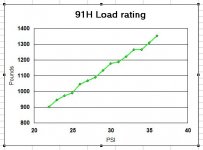There have been numerous post all over this community forum focusing on the question of what is the optimal rear tire pressure for a replacement car tire on a Spyder. The resultant answers range from 18-30 PSI. After much research, I decided to go with the Kuhmo Ecsta AST(225/50R15 91H) tire on my RT Limited.
Today I found hard data regarding a 91H rated tire vs. a 76H rated tire from the TRA Standard Load Inflation Table
PSI Load Index
22- 904 lbs vs. 584 lbs
23- 948 lbs vs. 617 lbs
24- 975 lbs vs. 634 lbs
25- 992 lbs vs. 650 lbs
26- 1047 lbs vs. 683 lbs
27- 1069 lbs vs. 697 lbs
28- 1091 lbs vs. 705 lbs
29- 1135 lbs vs. 739 lbs
30- 1179 lbs vs. 772 lbs
31- 1190 lbs vs. 779 lbs
32- 1224 lbs vs. 794 lbs
33- 1268 lbs vs. 827 lbs
34- 1268 lbs vs. 838 lbs
35- 1312 lbs vs. 849 lbs
36- 1356 lbs vs. 882 lbs
I could not find data for <22PSI. The data's end point is 36 PSI because that represents the maximum pressure for the tire by TRA.
To say that this data is an eye opener is an understatement. Using my riding style(2-up 95%) as the example, I've got my Kenda inflated between 28-29 PSI (705-739 lbs load). When I change to the Kumho, based on the data, I could run it @22lbs and have more "strength" in it compared to the nominal pressure for the OEM tire. What I need to know is this the data that I should be looking at?????
Mike
Today I found hard data regarding a 91H rated tire vs. a 76H rated tire from the TRA Standard Load Inflation Table
PSI Load Index
22- 904 lbs vs. 584 lbs
23- 948 lbs vs. 617 lbs
24- 975 lbs vs. 634 lbs
25- 992 lbs vs. 650 lbs
26- 1047 lbs vs. 683 lbs
27- 1069 lbs vs. 697 lbs
28- 1091 lbs vs. 705 lbs
29- 1135 lbs vs. 739 lbs
30- 1179 lbs vs. 772 lbs
31- 1190 lbs vs. 779 lbs
32- 1224 lbs vs. 794 lbs
33- 1268 lbs vs. 827 lbs
34- 1268 lbs vs. 838 lbs
35- 1312 lbs vs. 849 lbs
36- 1356 lbs vs. 882 lbs
I could not find data for <22PSI. The data's end point is 36 PSI because that represents the maximum pressure for the tire by TRA.
To say that this data is an eye opener is an understatement. Using my riding style(2-up 95%) as the example, I've got my Kenda inflated between 28-29 PSI (705-739 lbs load). When I change to the Kumho, based on the data, I could run it @22lbs and have more "strength" in it compared to the nominal pressure for the OEM tire. What I need to know is this the data that I should be looking at?????
Mike
Last edited:


